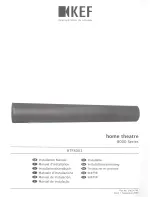
Proceedings of the Institute of Acoustics
Vol. 25. Pt 4. 2003
AN AUTOMATED IN-SITU FREQUENCY RESPONSE OP-
TIMISATION ALGORITHM FOR ACTIVE LOUDSPEAKERS,
INCLUDING A STATISTICAL ANALYSIS OF ITS PER-
FORMANCE
Andrew Goldberg
Genelec Oy, Olvitie 5, 74100 Iisalmi, Finland.
Aki Mäkivirta
Genelec Oy, Olvitie 5, 74100 Iisalmi, Finland.
1 INTRODUCTION
This paper presents a system to optimally set the room response controls currently found on full-
range active loudspeakers to achieve a desired in-room frequency response. The active loudspeak-
ers
1
to be optimised are individually calibrated in anechoic conditions to have a flat frequency re-
sponse magnitude within design limits of ±2.5 dB.
When a loudspeaker is placed into the listening environment, the frequency response changes due
to loudspeaker-room interaction. To help alleviate this, the active loudspeakers incorporate a prag-
matic set of room response controls, which account for common acoustic issues found in profes-
sional listening rooms.
Although many users have the facility to measure loudspeaker in-situ frequency responses, they of-
ten do not have the experience of calibrating loudspeakers. Significant variance between calibra-
tions can be seen even with experienced system calibrators. Additional variance will occur with dif-
ferent people calibrating loudspeaker systems. An automated calibration method was developed to
ensure consistency of calibrations because of these reasons.
Presented first in this paper is the discrete-valued room response equaliser employed in the active
loudspeakers. Then, the algorithm for automated value selection is explained including the software
structure, algorithm, features and operation. The performance of the optimisation algorithm is then
investigated by studying the statistical properties of frequency responses before and after equalisa-
tion.
2
IN-SITU EQUALISATION AND ROOM RESPONSE CONTROLS
2.1 Equalisation
Techniques
The purpose of room equalisation is to improve the perceived quality of sound reproduction in a lis-
tening environment, not to convert the listening room anechoic. In fact, listeners prefer to hear some
room response in the form of liveliness creating a spatial impression and some envelopment
2
.
An approach to improve the loudspeaker performance in a room is to choose an optimal location for
the loudspeaker. Cox and D’Antonio
3
(Room Optimiser) use a computer model of the room to find
optimal loudspeaker positions and acoustical treatment location to give an optimally flat in-situ fre-
quency response magnitude. Positional areas for the loudspeaker and listening locations can be
given as constraints to limit the final solution. Problems with this approach are that optimisation may
not be practically possible in all cases.
Electronic equalisation to improve the subjective sound quality has been widespread for at least 40
years; see Boner & Boner
4
for an early example. Equalisation is particularly prevalent in profes-
sional applications such as recording studios, mixing rooms and sound reinforcement, typically us-
ing a separate equaliser, although equalisers are increasingly built into active loudspeakers. Some
equalisers play a test signal and alter their response according to the in-situ transfer function meas-
ured
5
. This process can be sensitive and simple ‘press the button and everything will be OK’ ap-
proach proves hard to achieve with reliability, consistency and robustness.
Equalisation may become skewed if based only on a single point measurement. The frequency re-
sponse in nearby positions can actually become worse after equalisation designed using only a sin-


































